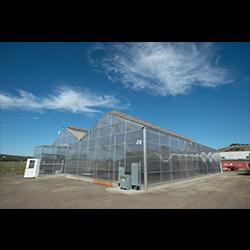College Opens Greenhouse for Asian Citrus Psyllid Research
Slideshow
This slideshow contains 7 slides that will change every 8 seconds. The first button is to play and pause the slideshow, followed by buttons to go to the previous slide, next slide, or choose individual slides.

To advance efforts to limit the spread of the Asian citrus psyllid, which can carry the deadly citrus plant disease Huanglongbing, the Cal Poly Pomona College of Agriculture announces the opening of a new 5,040-square-foot research and insect production greenhouse.
The greenhouse was planned in collaboration with the Citrus Research Board and constructed through a $400,000 grant from the Citrus Pest & Disease Prevention Program, which is funded by California citrus growers. It will support the research and rearing of the Tamarixia radiata wasp, a natural parasite of the Asian citrus psyllid, and advance efforts to lower populations of the psyllid through biological control. Cal Poly Pomona, the Citrus Pest & Disease Prevention Program and California Citrus Mutual hosted a ribbon-cutting event July 25 to unveil the greenhouse to a group of citrus industry, university and research leaders.
“Huanglongbing is the biggest threat the California citrus industry has ever faced,” said Nick Hill, chairman of the Citrus Pest & Disease Prevention Program and San Joaquin Valley citrus grower. “While biological control is not a silver bullet, it helps lower populations of the Asian citrus psyllid, thus limiting the opportunities for Huanglongbing to spread. As the psyllid becomes more established in new regions across the state, the ability to research and rear more Tamarixia will be critical.”
As part of the state’s biological control program Tamarixia are released in urban areas of Southern California – where the psyllid is widely established and eradication is no longer possible. Currently, the largest Tamarixia rearing facility in California supports the release of approximately 2 million wasps a year.
“Our goal for this facility is to maximize production of the wasps and increase biocontrol releases in California by a significant percentage,” said Valerie Mellano, chair of Cal Poly Pomona’s Department of Plant Science whose faculty and students will be conducting research and assisting in production of insects. “To raise the wasps, we will also need to raise the Asian citrus psyllid, and the new greenhouse allows us to rear both the psyllid and wasp in a safe, contained environment.”
Asian citrus psyllids feed on the leaves and stems of citrus and curry plants. The research will include employment of hydroponic growing systems and tissue cultures to create genetically uniform plants for the psyllids to feed upon. The more psyllids researchers can rear, the more Tamarixia wasps they can likewise produce. The university holds a permit from the California Department of Food & Agriculture to raise the insects in a controlled environment.
“Research collaborations such as this are an important part of the fight to prevent Huanglongbing from taking hold in California,” said Joel Nelsen, president of the citrus grower’s trade association California Citrus Mutual and presenter at the ribbon-cutting event. “Huanglongbing is a death sentence for our state’s citrus industry and we are using all means possible to make an impact. The citrus industry supports and applauds all research that will help us win this fight.”
For more information about the Citrus Pest & Disease Prevention Program and California Citrus Mutual, visit CaliforniaCitrusThreat.org and CaCitrusMutual.com, respectively.
